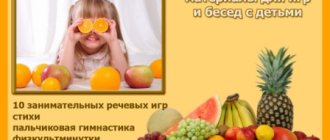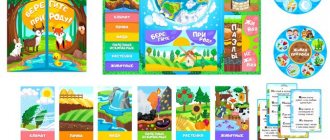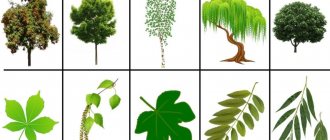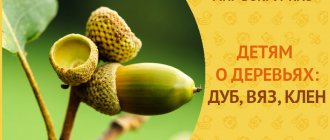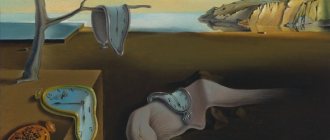LAPBUK "Trees". educational and methodological manual (senior, preparatory group) on the topic
LAPTOP “TREES”
In the educational thematic folder “Trees” the child will find stories, poems, and riddles about trees; information about the features of their structure, growth, why and who they are needed for, the possibility of using wood. The lapbook contains many colorful illustrations and interesting interactive elements that are sure to attract children's attention. The manual develops logical thinking, outlook, cognitive interest and speech activity; forms elementary ecological ideas.
This is what the cover of the “Seasons” lapbook looks like.
And this is what it looks like when opened.
What's inside the Trees lapbook?
The “Trees” lapbook includes 9 educational elements:
- Envelope “Tell children about trees.”
On the title side of the envelope there is a diagram “Structure of a tree”. On the back cover there is a small diagram “The Meaning of Forests”. Inside the envelope is a series of cards with images of trees and printed information that introduces children to the diversity and characteristics of trees and their use by humans. As an activity for speech development, colorful cards are used to compose sentences and descriptive stories. And the proposed poems and riddles are good for memorizing.
- Envelope with cards “What first, what then?”
The envelope contains a series of cards for the game “What First, What Then?” The game develops an understanding of simple cause-and-effect relationships, teaches how to construct sentences using the words because, because, therefore.
- Envelope “Who needs trees in the forest?”
The envelope contains 9 cards that will help formulate the concept that a tree can be a home for animals, birds, insects; benefit forest inhabitants.
- Folder insert "Complete the tasks."
This section presents poems, proverbs, riddles about trees for children to read and memorize; finger games on the theme “Trees” for the development of fine motor skills of the hand. As well as a thematic coloring book with tasks aimed at developing the thinking and attention of preschoolers; didactic game “The fourth odd one” for developing children’s ability to classify objects according to one criterion.
- Insert “Trees of Russia”.
- Insert “How to draw a tree?”.
- Envelope “Trees through the eyes of Russian artists.”
The envelope contains paintings by Russian artists: I.I. Shishkina, I.I. Levitan, A.K. Savrasova. The child not only gets acquainted with painting, but also, using supporting phrases, composes a story based on the picture. If you wish, you can include an interactive part of the lesson - cut and then assemble these pictures from puzzle strips.
- Envelope with cut cards “Trees, fruits, leaves.”
The envelope materials are interactive cards on the cognitive and speech development of children. The child is invited not only to look at and name the pictures, but also to act with them in different ways: read the names of trees, leaves and fruits; pick leaves and fruits from trees; write a descriptive story. This interactive approach promotes better memorization and learning of the material.
- Envelope with cards “What is made of wood.”
The envelope contains 18 cards with images of wooden objects. A selection of subject pictures is aimed at expanding knowledge about the world around us, enriching children's vocabulary and active vocabulary.
What is a lapbook
Lapbook is translated from English as “lap book.” This is a folder or accordion book with pockets, windows, sliding elements, inserts, envelopes in which tasks on a specific topic are hidden. When folded, a lapbook usually fits into A4 format, and when opened, into A3. A folder of this size is convenient to place on your lap.
With the help of homemade books, preschoolers and primary schoolchildren learn information in the simplest and most natural way for them - through play.
Lapbook for English classes
The child not only learns the names of edible and inedible mushrooms, but plays “Collect mushrooms”: he puts the edible ones in a basket and leaves the poisonous ones in the “clearing.” It is enough to cut out mushrooms from cardboard and attach them with Velcro to the image of the clearing, and make the pocket in the shape of a basket.
How to use a laptop
You can use a laptop at home, in kindergarten and at school. The process will be equally exciting.
In family
For parents, a lapbook is just a godsend. Family members spend time together and gain valuable teamwork experience:
- get to know each other better;
- develop creativity;
- learn to value their own and other people’s work.
Lapbook is an original replacement for photo albums. It can be dedicated to the history of the family and significant events in the child’s life. A ready-made version will not work: you need to put your soul into a “family” lapbook.
It’s a nice gift to give a laptop for a birthday: put postcards, compliments from relatives, or a “Find your gift” card in a beautifully designed folder.
Children learn about the world around them through tactile sensations. You can collect different materials into a lapbook - fabric, wood, plastic, cardboard, metal. The samples need to be well secured to make the process safe.
Older children will be interested in making their own lapbook on a topic close to them: domestic and wild animals, seasons, games - the list is inexhaustible.
In kindergarten
In kindergarten they use information folding beds, classic thematic folders, and screens for the little ones.
The manual meets the principles of preschool education according to the Federal State Educational Standard:
- allows the child to choose the content of education;
- helps to establish cooperation between children and adults, kindergarten and parents;
- ideally adapted to the age characteristics of a preschooler;
- arouses the child's interest.
Alevtina Gar, teacher of the senior group of kindergarten (Yoshkar-Ola):
“The laptop can be used even in a nursery group. The very first lapbooks are more like busy boards; they develop fine motor skills. They are easy to make yourself: we take large, dense, stable screens and attach laces, buttons, snaps, hooks, ropes, ribbons, zippers to them. Children enjoy learning new skills.
Then the tasks become more complicated: the preparatory group solves mathematical examples, exercises on letter knowledge and reading skills.
A lapbook makes it easy to organize material in a compact, visual, and most importantly interesting way for children. It’s mobile: it’s easy to take out and deploy, and at the same time it doesn’t require a lot of storage space.”
When a lapbook contains both educational and entertaining tasks - coloring, solving riddles, going through a maze, putting together a puzzle, sorting, naming, answering questions - this keeps children’s attention with a constant change of activities. A lapbook is convenient for displaying demo material with interactive elements.
At school
At school, the content of the laptop changes - there are fewer entertaining tasks and more educational ones. He teaches schoolchildren to absorb information well and obtain it themselves.
Teacher of the highest category Vera Davydova (Perm):
“We use lapbooks to consolidate topics, research papers, to structure information and present it visually. It helps present even the most complex and boring topic in an exciting and interesting way. This combines different types of activities.
The laptop can be used in different grades - from first to fourth. First we take general topics, then more specific ones.”
A laptop allows you to prepare an entire research project dedicated to a holiday or memorable date. Schoolchildren independently search for information, think over the design and content of the project folder, and prepare it.
A laptop makes learning a foreign language more interesting. The student learns vocabulary on the topic and learns to apply it: collects visual materials, composes crosswords. In the process, he repeats what he has learned many times and remembers it. While the children are working with the folder - looking at pictures, playing, opening pockets with assignments - they repeat what they have learned without them noticing.
